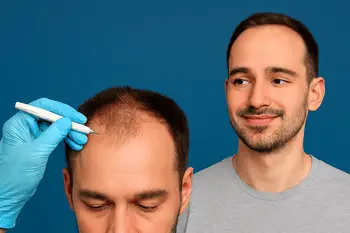
Hair transplant procedures in China have grown rapidly as demand for aesthetic treatments increases across the country and among international medical travelers.
This guide explains common techniques, realistic costs, clinic selection criteria, before-and-after expectations, recovery and follow-up, regulatory and safety considerations, and travel planning for patients considering a hair transplant in China.
Why choose China for a hair transplant
China offers a wide range of hair restoration services from local clinics in major cities to internationally accredited hospitals.
Several factors draw patients:
- Cost competitiveness: China often offers lower per-graft prices than many Western countries while providing access to modern techniques such as FUE and FUT. china-hospitals.com.
- Large and growing market: The domestic hair transplant market has expanded substantially, driven by rising disposable income, greater acceptance of aesthetic procedures, and technological adoption in clinics markwideresearch.com.
- Access to qualified specialists: Major urban centers such as Beijing, Shanghai, and Guangzhou host clinics staffed by experienced surgeons and technicians who perform high-volume procedures.
Common hair transplant techniques
Follicular Unit Extraction (FUE)
FUE removes individual follicular units from the donor area and implants them into the recipient area.
Benefits include minimal linear scarring, faster healing, and suitability for short hairstyles.
Follicular Unit Transplantation (FUT)
FUT removes a linear strip of scalp from the donor area, from which grafts are dissected.
This technique can yield a high number of grafts in a single session but results in a linear scar.
Advanced and adjunct techniques
- Robotic-assisted extraction and implantation can increase precision for some clinics.
- Platelet-rich plasma (PRP) therapy is commonly used after transplant sessions to support healing and graft survival.
- Scalp micropigmentation (SMP) can complement transplants for improved density appearance.
Realistic cost expectations
Cost structures vary significantly by clinic, technique, surgeon experience, and graft count.
Typical cost drivers:
- Price per graft: Many clinics price by graft; reported international comparisons show wide country variance and place China among cost-efficient options china-hospitals.com Medihair.
- Total grafts needed: Medium to large sessions commonly range from 1,500 to 4,000 grafts depending on Norwood scale and desired density.
- Package components: Consultation, surgery, anesthesia, overnight stay, medications, PRP sessions, and postoperative follow-ups.
Table: Typical cost range estimates
| Item | Typical range | Notes |
|---|---|---|
| Price per graft in China | $1–$4 | Varies by clinic, surgeon, technique china-hospitals.com Medihair. |
| Small session (800–1,200 grafts) | $800–$4,800 | Often one-day procedures. |
| Medium session (1,500–2,500 grafts) | $1,500–$10,000 | Common for moderate baldness. |
| Large session (3,000–4,000+ grafts) | $3,000–$16,000 | May require multiple days or staged sessions. |
Sources: china-hospitals.com Medihair.
Choosing the right clinic and surgeon
Credentials and experience
Verify surgeon qualifications, board certifications, and years of focused hair-restoration experience.
High-volume experience correlates with predictable graft survival and natural-looking hairlines.
Before-and-after portfolios
Ask for unedited before-and-after photos of patients with similar hair loss patterns and ethnic hair types.
Request contactable patient references when possible.
Techniques and team
Confirm whether the surgeon personally performs key steps (extraction, recipient site creation, implantation) and whether a trained team supports the operation.
Accreditation and hygiene
Look for hospital or clinic accreditation, transparent infection-control protocols, and modern operating-room standards.
Preoperative preparation
Medical evaluation
Full medical history, medication review, and scalp assessment are required to plan graft number and technique.
Some medications must be paused pre-surgery.
Expectations and planning
Discuss realistic goals, hairline design, and expected number of grafts.
Plan for photography, shaving preferences, and travel logistics around the operation and immediate recovery.
The surgical day
- Typical anesthesia: local anesthesia with sedation as needed.
- Procedure length: small sessions 2–4 hours, large sessions 6–10+ hours over one or more days.
- Comfort measures: clinics often provide rest areas, light meals, and aftercare instructions.
Recovery timeline and aftercare
Immediate post-op (first 1–7 days)
Scabbing, mild swelling, and tenderness are common.
Follow clinic guidance on cleaning, sleeping position, and activity restrictions to protect grafts.
Early healing (1–4 weeks)
Scabs fall off; transplanted hairs often shed (shock loss) before a new growth phase begins.
Continued use of prescribed topical treatments or oral medications may be recommended.
Hair growth phase (3–12 months)
New hair appears gradually; substantial cosmetic improvement is typically visible around 6–9 months and continues to mature up to 12–18 months.
Long-term maintenance
Some patients require additional sessions to increase density or address progressive native hair loss; medical therapies like finasteride and minoxidil are commonly used to preserve native hair.
Risks and complication management
Common complications are usually minor: infection, temporary swelling, and scarring.
Less common risks include poor graft survival, unnatural hairline, and cyst formation.
Good clinic protocols and surgeon experience minimize risks.
Legal, regulatory and safety considerations in China
China’s hair transplant market is regulated by national and local medical authorities.
Reputable hospitals and clinics operate under medical licensing rules and adhere to local infection-control standards.
Patients should verify clinic licensing and observe visible hygiene standards during consultations.
Market growth has led to a proliferation of providers, so due diligence is critical markwideresearch.com.
Medical tourism practicalities
Best cities for hair transplant
Beijing, Shanghai, Guangzhou, Shenzhen, and Hong Kong (for those seeking city-based options) host many reputable clinics and hospitals.
Travel and visa planning
Plan travel to allow pre-op consultation, the procedure, and at least 7–14 days of initial recovery before long-haul flights.
Confirm visa requirements for your nationality and allow buffer days for unexpected follow-ups.
Accommodation and translation
Choose accommodation near the clinic for easy follow-up visits.
Many clinics offer concierge services, local translators, or international patient coordinators to facilitate communication and logistics.
Cost savings vs. follow-up needs
International patients can achieve cost savings, but must factor in travel, accommodation, and potential return trips for staged procedures or complications.
How to verify clinic claims and patient reviews
- Seek independent reviews on third-party platforms rather than relying solely on clinic testimonials.
- Confirm claims about “per-graft” pricing to understand what is included (e.g., anesthesia, follow-ups).
- When possible, arrange a live video consultation to assess transparency and surgeon communication style.
Sample decision checklist before booking
- Surgeon qualifications: Licensed surgeon specialized in hair restoration.
- Clinic accreditation: Hospital or clinic licensure and clean operating rooms.
- Technique suitability: FUE, FUT, or hybrid approach recommended based on donor supply and goals.
- Transparent pricing: Itemized estimate and included services.
- Before/after evidence: Verified patient photos and references.
- Post-op plan: Clear follow-up schedule and emergency contact.
- Travel logistics: Accommodation, translator, and recovery time planned.
Cost comparison context
Global cost studies show broad per-country variation, with some countries offering much lower prices than others, and China generally positioned as cost-effective in many comparisons Medihair.
Cost should be balanced with surgeon skill, outcomes, and safety.
Table: Quick country cost comparison (illustrative)
| Country | Typical price per graft | Comment |
|---|---|---|
| China | $1–$4 | Cost-effective option with many modern clinics china-hospitals.com Medihair. |
| Turkey | $0.8–$3 | Known for competitive pricing and specialized clinics Medihair. |
| USA/Canada | $3–$6+ | Higher labor and clinic costs; premium pricing Medihair. |
Sources: china-hospitals.com Medihair.
Questions to ask during consultation
- How many grafts do you recommend and why?
- Who will perform each part of the procedure?
- What is your graft survival rate and long-term follow-up protocol?
- Can I speak with past patients or see unedited, dated before/after photos?
- What is included in the quoted price and what could cost extra?
Financing, refunds, and contracts
Many clinics provide payment plans or financing options.
Ensure any agreement includes refund or revision policies in case of unsatisfactory results or complications.
Aftercare products and adjunct treatments
- Finasteride and minoxidil: Widely used to protect native hair and improve transplant results.
- PRP: Often offered to enhance healing; effectiveness varies by patient.
- SMP: Useful for visual density enhancement when hair density is limited.
Final considerations and realistic expectations
A successful transplant balances patient goals and realistic expectations.
Hairline design, graft survival, and long-term maintenance require skilled planning.
Costs in China can be favorable, but careful clinic selection, transparent pricing, and clear follow-up plans are essential for a successful outcome.
Useful external links
- China Hospitals directory: https://china-hospitals.com/treatment/hair-transplant-surgery/ china-hospitals.com.
- Market research overview on China hair transplant market: https://markwideresearch.com/china-hair-transplant-market/ markwideresearch.com.
- Global hair transplant cost comparison: https://medihair.com/en/hair-transplant-cost/ Medihair.


